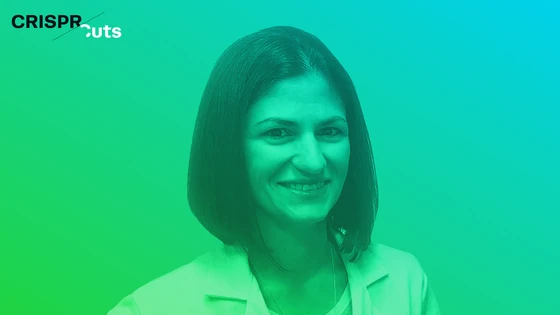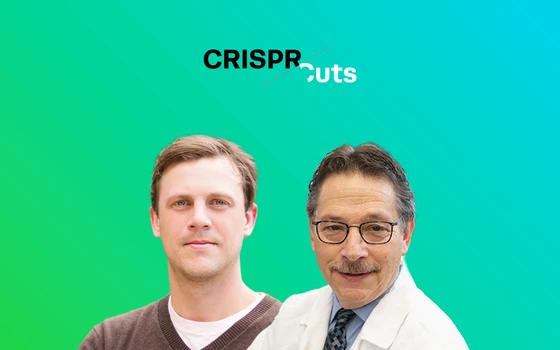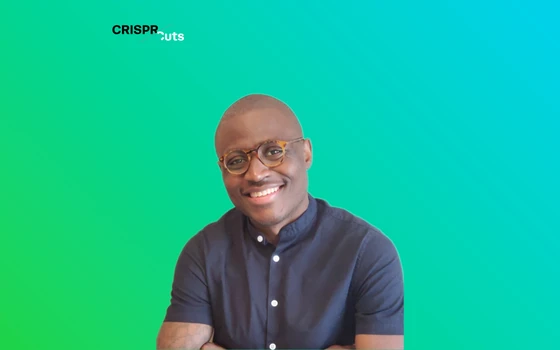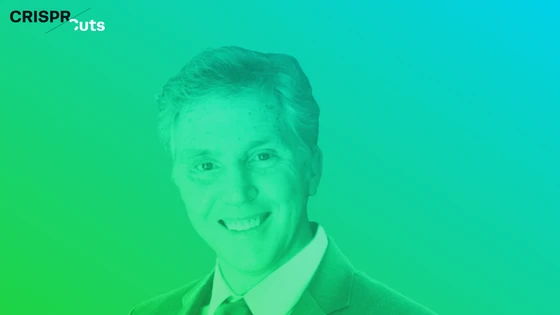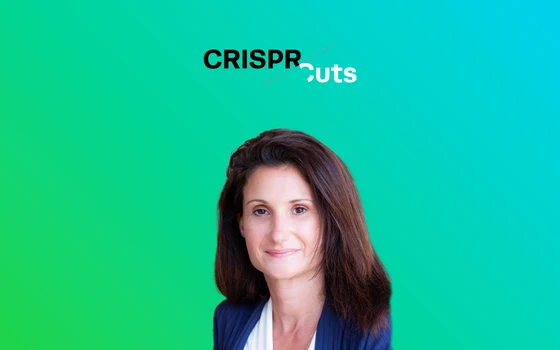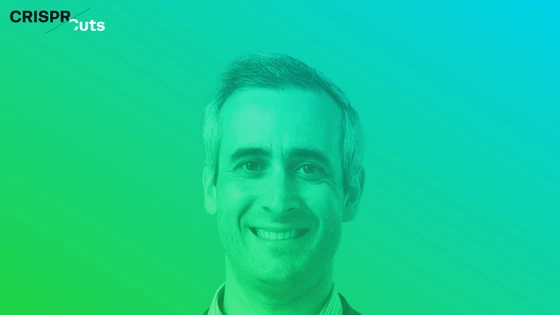CRISPR Cuts is Synthego’s official podcast, where scientists-turned-marketers Kevin Bryant & Minu Prabhune discuss the latest genome engineering news with CRISPR experts to inform and educate both scientists and non-scientists.
In this episode, the CRISPR Cuts team meets Cody Gough and Ashley Hamer from the award-winning Curiosity podcast. We discuss the ins and outs of CRISPR, chat about the public perception of new technologies, and discuss the need for better science communication. Tune in to the podcast or read on for a summary - the choice is yours!
Cody Gough: Why should everybody be paying attention to CRISPR?Kevin Bryant: The most exciting thing about the CRISPR technology is that it's going to be a part of everybody's everyday life in the near future. It's going to redefine medicine, agriculture, and many other areas. I think a lot of people are starting to hear a little bit about CRISPR, and in the coming years, it's going to become part of everyone's everyday conversations.
Kevin Bryant: The most exciting thing about the CRISPR technology is that it's going to be a part of everybody's everyday life in the near future. It's going to redefine medicine, agriculture, and many other areas. I think a lot of people are starting to hear a little bit about CRISPR, and in the coming years, it's going to become part of everyone's everyday conversations.
Cody: Can you give us a little background about Synthego?Kevin: We have an interesting backstory. We are a startup biotech company here in Silicon Valley, California. Our founders are actually not from the biology space; they are former SpaceX engineers who have brought their engineering mindset and way of thinking to the biotech industry. What that means is using software and very controlled processes to have better control over the life sciences. One of the biggest issues in biology is trying to control all the variables when doing an experiment, which is quite a bit different from how engineering works, where you have very tight control over the experiments. They are bringing that approach and way of thinking to the life sciences.
One specific example is that we have developed an automated robotic platform to conduct these experiments. Every step along the way is very tightly controlled: temperature in the room, the pressure, the humidity, the speed at which liquid is being transferred from one well to another, etc. Ultimately, if you can better control your experiments, you can better predict what the outcomes will be. It's really a unique approach to life sciences.
Kevin: We have an interesting backstory. We are a startup biotech company here in Silicon Valley, California. Our founders are actually not from the biology space; they are former SpaceX engineers who have brought their engineering mindset and way of thinking to the biotech industry. What that means is using software and very controlled processes to have better control over the life sciences. One of the biggest issues in biology is trying to control all the variables when doing an experiment, which is quite a bit different from how engineering works, where you have very tight control over the experiments. They are bringing that approach and way of thinking to the life sciences.
One specific example is that we have developed an automated robotic platform to conduct these experiments. Every step along the way is very tightly controlled: temperature in the room, the pressure, the humidity, the speed at which liquid is being transferred from one well to another, etc. Ultimately, if you can better control your experiments, you can better predict what the outcomes will be. It's really a unique approach to life sciences.
Cody: Let's say I go to Synthego and I look at one of your CRISPR kits. What is that used for, who is using that, and what is it able to do?Kevin: All our products are being used by scientists at academic institutes or other companies, including startup biotechs and large pharma companies. These are used by scientists who know how to use CRISPR and they want the best possible results in their experiments.
We have two main product families; one of our products is the CRISPR guide RNA and our main product in that family is synthetic single guide RNA that has been modified so that it is more stable and just works better in cells. Single guide (sg) RNA is one of the two components of the CRISPR-Cas9 system (the other being Cas9 nuclease). These sgRNAs essentially guide Cas9 to tell it where it should be cutting DNA. Where that cutting takes place is where the genome can be engineered.
We have developed this completely new RNA factory to better control RNA synthesis. We call it full stack genome engineering approach to CRISPR. This means that we can help scientists from the beginning of the CRISPR workflow all the way through the end. That starts with helping them choose which guide RNAs would work best, making those guide RNAs for their editing, and helping analyze the results after the edits have been performed.
Even one step beyond that is our new product family called Engineered Cells. These products cater to scientists who want to use CRISPR but don't want to spend the time learning how to use it in terms of the experimental methods. They don't need to spend the time optimizing their protocol; they can just get results. In those cases, these scientists choose their gene, pick their cell line, and then we do the gene editing for them. There are few different products under that area. We can send a pool of CRISPR knockout cells which have very high editing efficiency.
One step further from that is a population of knockout clones, where the individual edit is verified and cloned, so that 100% of the cells contain the specific edit that the scientists wanted. We also have another product called “Advanced Cells”, which is any kind of edit that the scientist wants in any cell type. That includes things like knocking in a gene. Scientists are often doing things like adding a GFP tag to their protein to find out where it goes in cells. It could be introducing a specific mutation into the gene that they are studying to try to mimic what happens in a specific cancer, for example.
Those are the main areas. It's either synthetic guide RNA for scientists who want to do CRISPR themselves, or engineered cells for the other scientists who would rather have us do the CRISPR for them. All of our products are guaranteed. If we are not able to do the edit, there is no charge. It takes that part of learning how to do something out of the equation so scientists now can access this technology and focus on the results that they want to obtain with it.
Ashley Hamer: It's amazing to me how quickly we have gone from biologists being able to do this in a lab to now it's a biotech thing where you just go on a website and you decide what gene you can change.
Kevin: I think that is really one of the most exciting things about CRISPR. It's application to being able to edit genes was just discovered a few years ago, five, six years ago and now, it's something that scientists don't even need to learn. In the past, researchers would have needed to dedicate multiple people, multiple months or years learning how to do a technique like CRISPR without any guarantee that they will be successful. Now they just focus on what they want to do with the CRISPR-edited cell.
Kevin: All our products are being used by scientists at academic institutes or other companies, including startup biotechs and large pharma companies. These are used by scientists who know how to use CRISPR and they want the best possible results in their experiments.
We have two main product families; one of our products is the CRISPR guide RNA and our main product in that family is synthetic single guide RNA that has been modified so that it is more stable and just works better in cells. Single guide (sg) RNA is one of the two components of the CRISPR-Cas9 system (the other being Cas9 nuclease). These sgRNAs essentially guide Cas9 to tell it where it should be cutting DNA. Where that cutting takes place is where the genome can be engineered.
We have developed this completely new RNA factory to better control RNA synthesis. We call it full stack genome engineering approach to CRISPR. This means that we can help scientists from the beginning of the CRISPR workflow all the way through the end. That starts with helping them choose which guide RNAs would work best, making those guide RNAs for their editing, and helping analyze the results after the edits have been performed.
Even one step beyond that is our new product family called Engineered Cells. These products cater to scientists who want to use CRISPR but don't want to spend the time learning how to use it in terms of the experimental methods. They don't need to spend the time optimizing their protocol; they can just get results. In those cases, these scientists choose their gene, pick their cell line, and then we do the gene editing for them. There are few different products under that area. We can send a pool of CRISPR knockout cells which have very high editing efficiency.
One step further from that is a population of knockout clones, where the individual edit is verified and cloned, so that 100% of the cells contain the specific edit that the scientists wanted. We also have another product called “Advanced Cells”, which is any kind of edit that the scientist wants in any cell type. That includes things like knocking in a gene. Scientists are often doing things like adding a GFP tag to their protein to find out where it goes in cells. It could be introducing a specific mutation into the gene that they are studying to try to mimic what happens in a specific cancer, for example.
Those are the main areas. It's either synthetic guide RNA for scientists who want to do CRISPR themselves, or engineered cells for the other scientists who would rather have us do the CRISPR for them. All of our products are guaranteed. If we are not able to do the edit, there is no charge. It takes that part of learning how to do something out of the equation so scientists now can access this technology and focus on the results that they want to obtain with it.
Ashley Hamer: It's amazing to me how quickly we have gone from biologists being able to do this in a lab to now it's a biotech thing where you just go on a website and you decide what gene you can change.
Kevin: I think that is really one of the most exciting things about CRISPR. It's application to being able to edit genes was just discovered a few years ago, five, six years ago and now, it's something that scientists don't even need to learn. In the past, researchers would have needed to dedicate multiple people, multiple months or years learning how to do a technique like CRISPR without any guarantee that they will be successful. Now they just focus on what they want to do with the CRISPR-edited cell.
Cody: That's not just limited to humans, right? What exactly are you editing, besides just human genes?Kevin: We are editing cell lines in lab culture. We are not talking about humans, we are talking about a cell line derived from humans. They are human cells, human genomes, but not humans or animals. You are right, CRISPR is not limited to humans or any animal species, as well as plants.
Minu: We have had some really fun conversations about all the different types of animal models CRISPR has been used because, say, twenty years back, mice was probably the only animal model that biologists could use for their experiments; even that was a big achievement. Now, the range of animals facing CRISPR has been used is amazing. We recently interviewed a researcher who uses CRISPR in cattle. It's really amazing how fast this technology has progressed and what we can do with it now.
Kevin: We are editing cell lines in lab culture. We are not talking about humans, we are talking about a cell line derived from humans. They are human cells, human genomes, but not humans or animals. You are right, CRISPR is not limited to humans or any animal species, as well as plants.
Minu: We have had some really fun conversations about all the different types of animal models CRISPR has been used because, say, twenty years back, mice was probably the only animal model that biologists could use for their experiments; even that was a big achievement. Now, the range of animals facing CRISPR has been used is amazing. We recently interviewed a researcher who uses CRISPR in cattle. It's really amazing how fast this technology has progressed and what we can do with it now.
Cody: What are some of the major challenges in presenting CRISPR to people?Minu: That's a very interesting question. First of all, people are obviously excited about anything that they think will improve their lives. But at the same time, not everyone realizes at what speed the technology is actually progressing. Even though we have had major progress in the field of CRISPR in the past few years, a potential to cure diseases technically doesn't translate to curing diseases tomorrow.
There needs to be better communication with the public just to set the expectations to demarcate hype from reality. People are either extremely skeptical that CRISPR is going to bring about the end of this world, or they are extremely positive that CRISPR is just going to cure everything and make us immortal. I think good education around what this technology is, what its pros are, what the caveats are, and what we are working through is very essential for setting these expectations. Which is why we are doing our podcast, CRISPR Cuts, and our Bench blog. One of our aims is to educate the audience who is not as familiar with CRISPR about what the current regulations are and what they can expect in the next few years and so on.
The second point is about regulations. I wouldn't say that is a hurdle, but it is definitely one major area that is going to or is currently slowing down the rate at which we might be going to clinical trials. That's not necessarily a bad thing though, considering that what eventually anyone using CRISPR would plan to do is send in these sgRNAs to specifically edit a gene. So, of course, we need to be very careful that this sgRNA will only edit that gene and will not go elsewhere and cause any harm that we hadn't thought of before. Scientists need to be extremely sure when they are doing their experiments before taking anything into the clinic that everything works as we expect it to and only then the regulations should and would be passed.
Kevin: Another interesting point is how will the general public perceive CRISPR? It really depends on how it is used. A lot of people kind of immediately think of GMOs when they hear of CRISPR and the historical baggage that comes with that phrase, but it really depends on how it is used. For example, I think people don't like that term when it is a company using the technology to make more money at the expense of human health of the environment, but if the technology is being used to create agricultural products more sustainably or improve their nutrition to feed the growing population or to increase nutritional value of food, or just to allow farmers to grow food more efficiently, I think people could support that.
Cody: I was actually just going to mention the whole GMO thing is quite a hot topic around here at Curiosity.
Ashley: It's a pet topic of mine. My experience has been that people don't want anyone in a lab coat to touch their food in any way, even if it is to improve the nutrition or to make things more sustainable. I'm afraid that the public might go that way with CRISPR too. That shows that maybe we have a lot of work to do on the public perception front of science in general to show that natural isn't always better and that a lot of time human ingenuity and science can really improve our lives and won't necessarily lead to the health crises that many people are afraid of.
Minu: That's a very interesting question. First of all, people are obviously excited about anything that they think will improve their lives. But at the same time, not everyone realizes at what speed the technology is actually progressing. Even though we have had major progress in the field of CRISPR in the past few years, a potential to cure diseases technically doesn't translate to curing diseases tomorrow.
There needs to be better communication with the public just to set the expectations to demarcate hype from reality. People are either extremely skeptical that CRISPR is going to bring about the end of this world, or they are extremely positive that CRISPR is just going to cure everything and make us immortal. I think good education around what this technology is, what its pros are, what the caveats are, and what we are working through is very essential for setting these expectations. Which is why we are doing our podcast, CRISPR Cuts, and our Bench blog. One of our aims is to educate the audience who is not as familiar with CRISPR about what the current regulations are and what they can expect in the next few years and so on.
The second point is about regulations. I wouldn't say that is a hurdle, but it is definitely one major area that is going to or is currently slowing down the rate at which we might be going to clinical trials. That's not necessarily a bad thing though, considering that what eventually anyone using CRISPR would plan to do is send in these sgRNAs to specifically edit a gene. So, of course, we need to be very careful that this sgRNA will only edit that gene and will not go elsewhere and cause any harm that we hadn't thought of before. Scientists need to be extremely sure when they are doing their experiments before taking anything into the clinic that everything works as we expect it to and only then the regulations should and would be passed.
Kevin: Another interesting point is how will the general public perceive CRISPR? It really depends on how it is used. A lot of people kind of immediately think of GMOs when they hear of CRISPR and the historical baggage that comes with that phrase, but it really depends on how it is used. For example, I think people don't like that term when it is a company using the technology to make more money at the expense of human health of the environment, but if the technology is being used to create agricultural products more sustainably or improve their nutrition to feed the growing population or to increase nutritional value of food, or just to allow farmers to grow food more efficiently, I think people could support that.
Cody: I was actually just going to mention the whole GMO thing is quite a hot topic around here at Curiosity.
Ashley: It's a pet topic of mine. My experience has been that people don't want anyone in a lab coat to touch their food in any way, even if it is to improve the nutrition or to make things more sustainable. I'm afraid that the public might go that way with CRISPR too. That shows that maybe we have a lot of work to do on the public perception front of science in general to show that natural isn't always better and that a lot of time human ingenuity and science can really improve our lives and won't necessarily lead to the health crises that many people are afraid of.
CRISPR 101 eBook
CRISPR has quickly become a standard laboratory tool for gene editing. As the adoption of CRISPR accelerates worldwide, up-to-date knowledge of the basics of CRISPR is essential for anyone in the field. From target identification studies to the recent breakthroughs in clinical trials, CRISPR is enabling scientists to unlock the power of the genome.
Download our CRISPR 101 eBook today to stay up to date on all your CRISPR basics and get the best results in your CRISPR experiments!
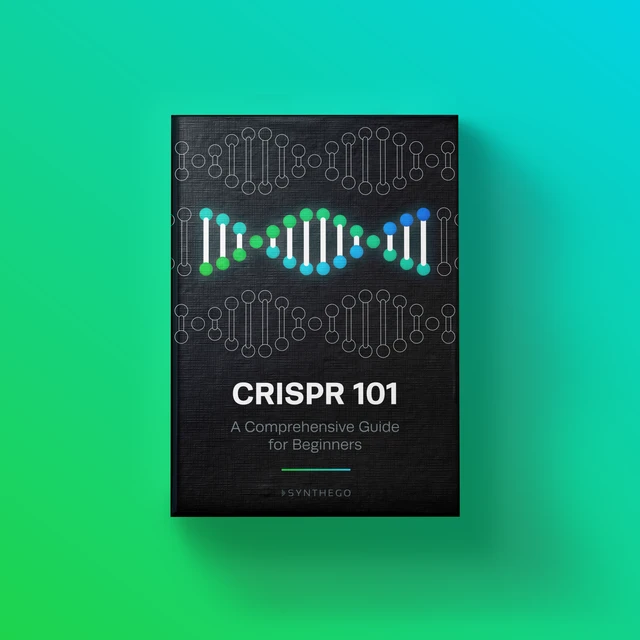
Minu: Absolutely. Actually, to that point, I think you are right in that people are really afraid of GMO food. There are many people who may not be supportive of that, but it also depends on how they perceive the term GMO, right? It's not even clear if they think that a gene has been taken from another species and introduced in a crop, because that's just one way. With CRISPR, you might just actually have to cut out one gene from a crop and there is no insertion of anything else from any other species. There's literally no contamination as such. Maybe people don't know this difference, and then that's our job to inform them and make this distinction between what they might be afraid of and what is actually being done. That might help create a positive public perception about this topic.
Cody: I'm just trying to imagine what kind of documentation is out there for this. Do you send an instruction manual "Here's how you edit certain genes!"?Kevin: We do include protocols for how to use the products. They might require optimization, as each scientist might be using a slightly different cell line or editing a different gene. There's not a one size fits all method, but we do provide protocols as guidelines. The research community is very active in this space. When scientists publish their results, as part of the publications, they write detailed accounts of their experimental methods. Any scientist that wants to repeat the results knows what they did.
Kevin: We do include protocols for how to use the products. They might require optimization, as each scientist might be using a slightly different cell line or editing a different gene. There's not a one size fits all method, but we do provide protocols as guidelines. The research community is very active in this space. When scientists publish their results, as part of the publications, they write detailed accounts of their experimental methods. Any scientist that wants to repeat the results knows what they did.
Cody: Do you think that a lot of people trying science communication about CRISPR are getting it right? When you read CRISPR news from various science publications, how do you perceive that?Kevin: A lot of podcasts and other media are having more coverage of this base, and yours is among the best. So, great work! While there are a lot of podcasts and mass media or sort of pop culture publications that are covering it, there really isn't much in terms of resources dedicated to covering genome engineering. That's kind of a gap we saw that we're trying to fill. In a lot of cases, a podcast like yourself covers this because it's so cool and it's one of the biggest technologies of our time. We are trying to take it a bit further and cover all the different angles that we can to make this new technology more accessible to everyone of all different levels.
On CRISPR Cuts, we have talked to other journalists that are covering CRISPR, top researchers using CRISPR to bring it to the clinic, and our own employees to explain their unique approach in this space.
Kevin: A lot of podcasts and other media are having more coverage of this base, and yours is among the best. So, great work! While there are a lot of podcasts and mass media or sort of pop culture publications that are covering it, there really isn't much in terms of resources dedicated to covering genome engineering. That's kind of a gap we saw that we're trying to fill. In a lot of cases, a podcast like yourself covers this because it's so cool and it's one of the biggest technologies of our time. We are trying to take it a bit further and cover all the different angles that we can to make this new technology more accessible to everyone of all different levels.
On CRISPR Cuts, we have talked to other journalists that are covering CRISPR, top researchers using CRISPR to bring it to the clinic, and our own employees to explain their unique approach in this space.
Cody: There was a big news in November that a Chinese researcher edited the genes in humans, which the international research community wasn't necessarily so on board with. Besides the ethical implications, what kind of challenges does this present, and what comes next?Minu: When I read this news, I was like, "What? It's CRISPR in humans already?’ The announcement, what you are talking about, was that this researcher in China claims that he edited human embryos and two twin girls were recently born from these edited embryos. These would be the first genome edited babies using CRISPR. It is important to point out that there has been a lot of coverage of this news in big publications, which is bound to be, but there has been no peer review of this research. This means that this is not like a regular paper which has been accepted by other experts.
This announcement came just one day before the second human genome editing summit, where experts from all over the world convene to discuss the scientific, ethical, and governance issues around genome editing. It's very encouraging to see that the research community takes this very seriously. There are investigations to see if the claims are true and, secondly, there have been discussions around this topic at the summit regarding what should be done, what should be the rules about this, and everything.
Today, we have a live example where someone is claiming that they have edited a human genome, and we can already see that scientists are dealing with it very responsibly. They are very critical, they are very skeptical, and they are taking big steps to see how this was done and to make sure that no one just goes on an editing rampage.
Whenever we have interviewed any CRISPR experts or researchers on our podcast or for our blog, all of them have always been very, very specific about this part. Although CRISPR has great potential, they are very careful with their experiments and everyone is very aware of what its impact could be on society.
Cody: It sounds like it's almost a relief to you to see that this is being taken seriously. No one can go back in time and change what happened, but at the very least, the scientific community is taking the conversations to the next level.
I know you have been talking about CRISPR a lot. I wanted to give you an opportunity if you wanted to ask us about anything about our perspective from Curiosity.
Minu: When I read this news, I was like, "What? It's CRISPR in humans already?’ The announcement, what you are talking about, was that this researcher in China claims that he edited human embryos and two twin girls were recently born from these edited embryos. These would be the first genome edited babies using CRISPR. It is important to point out that there has been a lot of coverage of this news in big publications, which is bound to be, but there has been no peer review of this research. This means that this is not like a regular paper which has been accepted by other experts.
This announcement came just one day before the second human genome editing summit, where experts from all over the world convene to discuss the scientific, ethical, and governance issues around genome editing. It's very encouraging to see that the research community takes this very seriously. There are investigations to see if the claims are true and, secondly, there have been discussions around this topic at the summit regarding what should be done, what should be the rules about this, and everything.
Today, we have a live example where someone is claiming that they have edited a human genome, and we can already see that scientists are dealing with it very responsibly. They are very critical, they are very skeptical, and they are taking big steps to see how this was done and to make sure that no one just goes on an editing rampage.
Whenever we have interviewed any CRISPR experts or researchers on our podcast or for our blog, all of them have always been very, very specific about this part. Although CRISPR has great potential, they are very careful with their experiments and everyone is very aware of what its impact could be on society.
Cody: It sounds like it's almost a relief to you to see that this is being taken seriously. No one can go back in time and change what happened, but at the very least, the scientific community is taking the conversations to the next level.
I know you have been talking about CRISPR a lot. I wanted to give you an opportunity if you wanted to ask us about anything about our perspective from Curiosity.
Kevin: On your podcast, Curiosity, you cover all areas of technology or sciences. I would like to hear a little bit more about the conversations you have been having with others about this and other related technologies.Ashley: I started at Curiosity about two and a half years ago. I remember then, CRISPR was this brand new thing that pop science media was just starting to talk about. I had just heard about it on Radiolab and it sounded like this futuristic, weird, out there thing that didn't really seem possible, and almost seemed like magic. Fast forward to now, and I think the general public is actually starting to understand what CRISPR is and can refer to it as something that involves gene editing.
I definitely agree with you in the perception of the public as it being either this magical cure all, or the end of the human race as we know it. It's either the best thing in the world, or the worst thing in the world.
Cody: I would like to add that at some point, it's changing now, but on the other extreme, there are people that just don't think it is really happening. I think that just getting the word out there is a thing that's important for us here at Curiosity, and that also extends to other areas. We have covered topics on science, especially with things like space exploration that, hey, this is here now. Hey, we are sending a lander onto an asteroid that's going to come back with an asteroid sample. Here's what it means.
I think that there's a lot of attention on space exploration right now because I think of Elon Musk and some of these big personalities getting involved and some of the stories they are able to tell. NASA is also hot on podcasts. They've got about 10 podcasts or so now, which is really impressive. They are all pushing that stuff, and I think that it's just part of the challenge with any science or psychology or research is getting people to not only understand the expectations and be like, "No, it's not the end of the world, and no it's not going to save everyone," but also just kind of the acknowledgement that it's there and letting them know that it exists and people are working on it. Yeah, we are going to keep on sciencing.
Ashley: I started at Curiosity about two and a half years ago. I remember then, CRISPR was this brand new thing that pop science media was just starting to talk about. I had just heard about it on Radiolab and it sounded like this futuristic, weird, out there thing that didn't really seem possible, and almost seemed like magic. Fast forward to now, and I think the general public is actually starting to understand what CRISPR is and can refer to it as something that involves gene editing.
I definitely agree with you in the perception of the public as it being either this magical cure all, or the end of the human race as we know it. It's either the best thing in the world, or the worst thing in the world.
Cody: I would like to add that at some point, it's changing now, but on the other extreme, there are people that just don't think it is really happening. I think that just getting the word out there is a thing that's important for us here at Curiosity, and that also extends to other areas. We have covered topics on science, especially with things like space exploration that, hey, this is here now. Hey, we are sending a lander onto an asteroid that's going to come back with an asteroid sample. Here's what it means.
I think that there's a lot of attention on space exploration right now because I think of Elon Musk and some of these big personalities getting involved and some of the stories they are able to tell. NASA is also hot on podcasts. They've got about 10 podcasts or so now, which is really impressive. They are all pushing that stuff, and I think that it's just part of the challenge with any science or psychology or research is getting people to not only understand the expectations and be like, "No, it's not the end of the world, and no it's not going to save everyone," but also just kind of the acknowledgement that it's there and letting them know that it exists and people are working on it. Yeah, we are going to keep on sciencing.
Ashley: I have also heard feedback that we don't want CRISPR to be made into something where only the rich have access to it and it widens the inequality gap between the rich and the poor. That's actually kind of how every scientific breakthrough has been. At first, anyway.Minu: That’s true- any kind of applications arising out of breakthroughs are highly priced in the beginning just because the technology and its applications might be so limited at that time. CRISPR, though is only five or six years old right now, and look at the progress it has made. We are all talking about it now in our daily lives. In the near future, hopefully, enough researchers will have access to CRISPR, which is one of the major names of Synthego to make sure that all researchers have access to CRISPR tools that eventually this will speed up the process of technology, it will reduce the cost of manufacturing if we streamline everything, and then, eventually, that might actually lead into a democratized medicines or therapies.
The hope is that it should not then be in a far away future. Because, you're right, eventually the costs will go down. It's all about how we define eventually. The aim is, basically, to reduce the time in making it accessible. That's what most researchers are actually hoping for and, yeah, let's hope that's soon enough when we can actually use CRISPR in medicine for everyone.
Cody: Any final thoughts on what's next for CRISPR or what gets you excited?
Kevin: I am most excited to see about all the ways that CRISPR will impact our lives that we haven't even thought about it yet. The world is facing a lot of problems and I think science will be the solution for most of them, technologies like CRISPR will particularly be key in solving these problems.
Minu: That’s true- any kind of applications arising out of breakthroughs are highly priced in the beginning just because the technology and its applications might be so limited at that time. CRISPR, though is only five or six years old right now, and look at the progress it has made. We are all talking about it now in our daily lives. In the near future, hopefully, enough researchers will have access to CRISPR, which is one of the major names of Synthego to make sure that all researchers have access to CRISPR tools that eventually this will speed up the process of technology, it will reduce the cost of manufacturing if we streamline everything, and then, eventually, that might actually lead into a democratized medicines or therapies.
The hope is that it should not then be in a far away future. Because, you're right, eventually the costs will go down. It's all about how we define eventually. The aim is, basically, to reduce the time in making it accessible. That's what most researchers are actually hoping for and, yeah, let's hope that's soon enough when we can actually use CRISPR in medicine for everyone.
Cody: Any final thoughts on what's next for CRISPR or what gets you excited?
Kevin: I am most excited to see about all the ways that CRISPR will impact our lives that we haven't even thought about it yet. The world is facing a lot of problems and I think science will be the solution for most of them, technologies like CRISPR will particularly be key in solving these problems.


